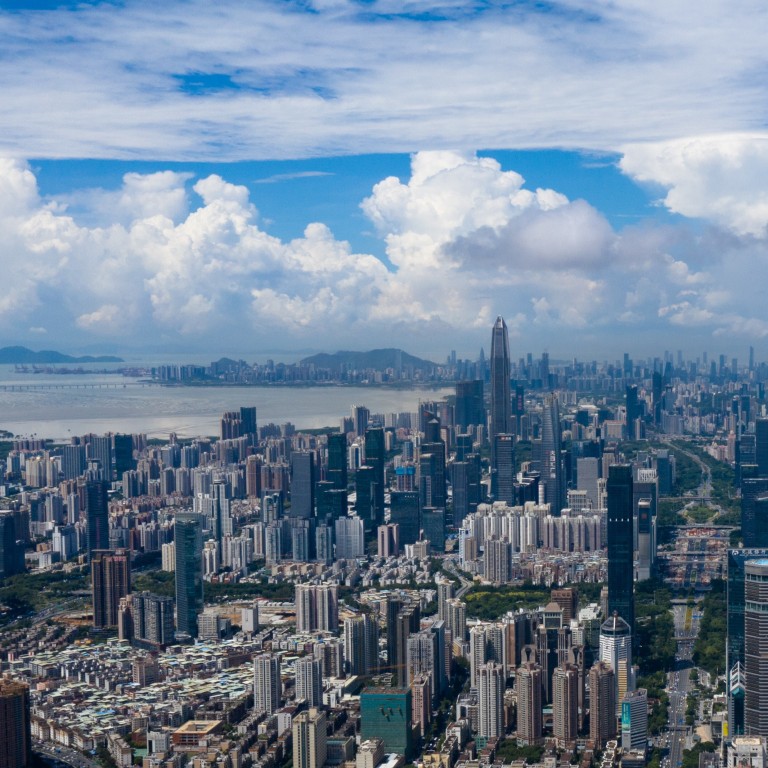
Shenzhen to focus on chips, AI and biomedicine to grow GDP 40 per cent over five years in the face of US hostility and economic slowdown
- China’s southern tech hub of Shenzhen aims for 40 per cent growth over five years, with eyes on becoming an international hub of innovation
- Shenzhen tech giants Huawei, ZTE and DJI have already been hurt by US sanctions, with Tencent also receiving hostility from Washington
Shenzhen, the southern boomtown hand-picked by Chinese President Xi Jinping as a model “socialist” city, has set lofty development and technology goals in a blueprint for 2025 and beyond, painting itself a bright future despite challenges from US sanctions and slowing economic growth at home.
The mainland city, which spent the last couple of decades transforming from a sweatshop manufacturing base into China’s answer to Silicon Valley, has hopes to boost its economy to 4 trillion yuan (US$612.8 billion) by 2025, when it aims to be a “modern international innovative city”, according to a blueprint published by the Shenzhen government this week. If achieved, the city’s economy would be more than 40 per cent larger than its estimated 2020 GDP of 2.8 trillion yuan.
According to the plan, the city will double both total and per capita GDP over the next 15 years, becoming “a capital of innovation, business and ideas with global influence” by 2035. This would mean a significantly lower growth than what it saw over the last 15 years, when the economy grew nearly fivefold, from 580 billion yuan in 2006 to 2.8 trillion yuan in 2020.
As part of its plan, the city aims to strengthen its role in fundamental research by prioritising areas including integrated circuits, artificial intelligence and biomedicine to become a “technological and industrial innovation high ground with global influence”.
However, Shenzhen’s ambitions are overshadowed by increasing hostility from Washington. Restrictions from the US have already limited growth outside China for Huawei Technologies Co. and ZTE, two telecoms equipment giants based in the city.
Shenzhen’s tech hub status turbocharged by Xi’s new policy blueprint
“Shenzhen can really feel the pain from US sanctions as some big companies on the US blacklist are from Shenzhen, and the city is urgently seeking tech self-reliance,” said Guo Wanda, executive vice-president of the China Development Institute, a think tank in Shenzhen.
“And Shenzhen’s plan on fundamental research and development is in line with China’s national strategy of seeking self-reliance in core technologies,” he added.
With Beijing’s push for more indigenous innovation, the national government hopes Shenzhen will be able to achieve breakthroughs in core technologies.
“[We should] improve the stable and continuous investment mechanism for fundamental R&D and guarantee the annual investment into fundamental R&D is not less than 30 per cent of the city’s scientific research fund,” the city’s plan said. “And [we should] accelerate the build-up of a national science centre and establish more national key laboratories.”
According to official data, basic research – the advancement of scientific theories that could later underpin new technology – accounted for only 6 per cent of China’s total annual research and development expenditures in 2019, lower than the 18 per cent in the US and 25 per cent in France.
Now there are high expectations for a city that has developed from a series of smaller towns and villages into a hi-tech metropolis in the 40 years since it was designated by former paramount leader Deng Xiaoping as the country’s first special economic zone. Today, Shenzhen is home to a number of the biggest names in China’s tech industry, including multimedia behemoth Tencent Holdings and drone maker DJI.
This rapid transformation has also come with growing pains, including soaring property prices that have given the city the lowest home ownership rates in the country.
“For the high price of property in Shenzhen, I do not think it will necessarily directly hurt innovation, but [it could] hurt the manufacturing industry in the city,” Guo said. “So it may block access to the city for white-collar workers, but not for hi-tech talent.”
Shenzhen: from fishing village to Silicon Valley of China in 40 years
The “technology high ground” vision is a key piece of Shenzhen’s blueprint for 2025 and 2035, a document of over 27,000 Chinese characters, which the city called part of “China’s national rejuvenation”.
The city also aims to be a centre of financial innovation and a destination for venture capital. While the plan does not directly mention competition with neighbouring Hong Kong, an international financial hub and gateway for investment into China, Shenzhen said it would seek a bigger role in the use of cross-border yuan.
Through the use of technology and finance, Shenzhen said it will become the “core engine” for the Greater Bay Area, an economic bloc that covers Hong Kong, Macau and nine mainland cities. Shenzhen said it will make it easier for Hong Kong and Macau residents to live and work in the city.
This blueprint for Shenzhen is also an articulated answer to Xi’s vision for the city.
In a wide-ranging speech to mark the 40th anniversary of the Shenzhen special economic zone in October, Xi asked the city to become a “technological and industrial innovation high ground” and to build a supply chain for hi-tech industries through innovation.
Shenzhen also hopes to become a research base in fields of quantum information, high-end medical equipment, brain science, cells and genes, aerospace technology, and deep sea technologies.

